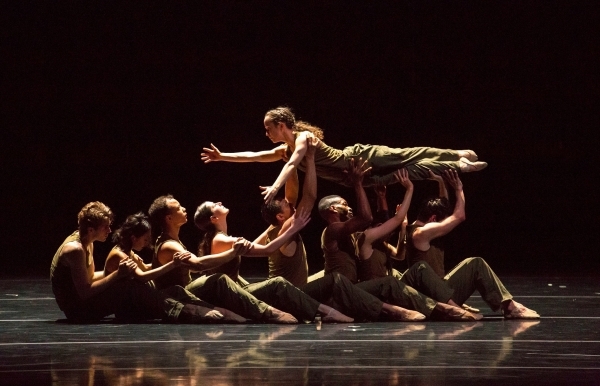
Jessica Lang Dance Company is back to NextMove Dance series. Originally from Philadelphia and a graduate of the Juilliard School, she has received some of the dance world’s most prestigious awards—2014 Bessie Award, 2017 Arison Award—and created choreographies for numerous well-known companies in the United States and internationally. Her selections for the program fits with her choreographies from throughout her career, showcasing an interest in diverse themes while preserving a recognizable style.
Solo Bach is, as the title says, choreographed to Bach’s Partita No. 3 for violin solo. Solo male dancer Patrick Coler, in simple costume, presents the Bach music through his movement. It is almost like a textbook: clean, tight, and strict to the basic technique of classical ballet. Just like Bach’s partita is sublime and simply beautiful with no frill and bling, the dancer’s movement depicts the exhilaration and clear beauty of the melody.
Among the Stars was inspired by the Japanese folklore story of Tanabata, the Star Festival. The myth says that lovers—Orihime, a princess who weaves beautiful fabrics, and Hikoboshi, a cowboy—were unfortunately separated with the Milky Way between them, and allowed to see each other only on July 7 if the sky is clear that night. Set to the serene and mystic music from “Snowy Village & The Girl” by Sakamoto Ryuichi, Laura Mead and Jammie Walker create the beautiful world of the legend of love on the stage. A long chiffon cloth is used effectively as a motif of the Milky Way, then wrapped around the female dancer as her dress, and finally turned into the bind that separates her from her lover. The beautiful and sorrowful dance takes the viewer’s breath away and fills the theater with sighs.
The next piece is Lang’s latest choreography, Her Road. The inspiration for the piece was Georgia O’Keeffe, and this is evident in the four female dancers’ costumes (simple white leotards with long and light skirts with blue gradation on the hems, like one of O’Keeffe’s painting of morning glory) and their poses—layers on layers creating beautiful patterns. The music Lang uses—Beethoven’s Spring Sonata for Violin and Piano—may also have been a strong inspiration for this dance. The dancers’ movements interact with each other and to the music as the violin and piano interact and harmonize. It is a ballet of women with passion, blooming like a flower in the spring.
The Calling was choreographed in 2006 to the music “O Maria, stella maris” by Trio Mediaeval. A dancer, Kana Kimura, stands still at the center of the empty stage. Her upper body is in simple leotard, but her legs are hidden inside a long skirt that spreads wide and covers most of the stage floor. Although her range of motion is limited by being binded at one spot of the stage, her arms and torso speak to the viewers in the most expressive movements. The setting of the choreography—keeping the core of the dancer at the center of the stage instead of moving the dancers around the stage—is intriguing and effective, allowing the viewer to feel the space around the dancer.
The last piece in the program, Thousand Yard Stare, is dedicated to veterans. It is choreographed to Third Movement: Adagio of String Quartet No. 15, Op by Beethoven. The dance unfurls like scenes of a movie. The dancers march in order as soldiers, collide into each other and crawl on the ground. One by one they fall, and their comrades are there to catch and raise them up. There is no direct indication of a war or a fight, nor clear patriotism in the choreography. With dimming lighting and shadow over the dancers, it is a deeply spiritual piece.
Lang’s choreographies, and the movement of her dancers, give the impression of being settling and modest. The dancers do not show hyper extensives kick or superhuman movements. They keep their bodies and arms in the correct positions of classical ballet and do not skip even small steps and bourrée in between their movements. This dedication to and appreciation of the basic rules and details of ballet support a clean and beautiful dance style and allow Lang’s dancers to be direct and vocal in expressing the music, the stories, and the emotions.
The program runs at the Prince Theater through Sunday, April 9, with different castings for the solos. [The Prince Theater, 1412 Chestnut Street] April 5-9, 2017; danceaffiliates.org
